SIMPLE STANDARDS OF DIFFERENT QUALITIES OF MEAT USED AS RAW MATERIAL FOR DIFFERENT PRODUCT QUALITIES
Manufacturers must aim for uniform quality of their meat products. To attain this, raw materials must be standardized for different qualities. Goodquality carcasses are usually divided into primal cuts (ham, shoulder, loin, neck, etc.). The remainder of the carcass and trimmings from the primal cuts are standardized into different qualities of meat. Poorer-quality carcasses are used entirely for processing after being deboned and trimmed.
Basic parameters for simple quality standards are size and shape of meat pieces, amount of visible fatty and connective tissues, and chemical composition. Meat must not contain skin, lymphatic glands, particles of bones, bristles, large blood vessels or blood clots.
Different qualities of meat
First quality (Meat I). Meat pieces of relatively uniform size and shape, trimmed of connective tissue, with about 8 percent visible fatty tissue obtained from larger primal cuts, mostly hindquarter. It is used to make meat batter for sausages and high-quality canned products (Fig. 129).
Second quality (Meat II). Meat pieces of irregular size and shape, partially trimmed of connective tissue with about 15 percent visible fatty tissue, obtained mostly from forequarters. It is used to manufacture meat batter, or medium-quality meat products (Fig. 130).
Lean trimmings are small irregular pieces of meat, with pervading connective and fatty tissue (about 25 percent), obtained during deboning and trimming of primal cuts, Meats I and II, and meat parts of the head and flank. They are used to make meat batter for all kinds of medium-and lowquality cooked sausages (Fig. 131).
Fatty trimmings are meat pieces containing about 50 percent visible fatty tissue, derived from all trimming operations. They are used as the fatty ingredient of meat batter of medium and low quality (Fig. 132).
Standards of fatty tissues
Ruminants
Firm (external) fatty tissues are trimmed from any part of the carcass and hump of zebu and are used as the fatty component of the meat batter or sausage mixture (mutton, goat, etc.) or all-beef higher-quality sausages.
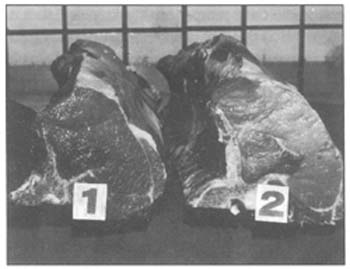 |
128. Cross-section of pork loins: DFD (1) and PSE (2) meat |
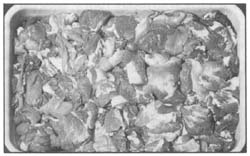 |
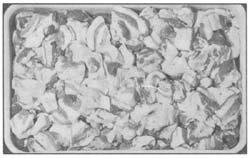 |
| 129. First-quality meat (Meat I) | 131. Lean trimmings |
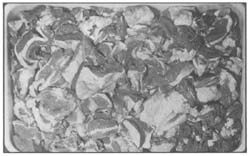 |
 |
| 130. Second-quality meat (Meat II) | 132. Fatty trimmings |
Soft (internal) fatty tissues are perirenal and sacral in origin and are not generally used in sausages.
Pork
Jowl (firm) contains much muscular (even up to 30 percent) and connective tissues. It is suitable for manufacturing dry sausages, summer sausages, salamis and emulsion-type sausages of the highest quality (Fig. 133).
Back fat (firm) is used for semi-dry and dry sausages, and in frankfurter sausages of the highest quality (Fig. 134).
Side fat (firm) contains about 60 percent visible fatty tissue. It is used to manufacture medium-quality cooked sausages made of uncooked or precooked materials (Fig. 135).
| 133. Pieces of pork jowl | 135. Uniformly sized and shaped pieces of pork side fat |
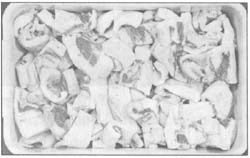 |
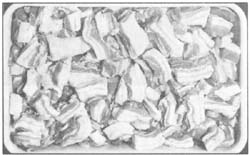 |
| 134. Pieces of pork back fat | 136. “Soft” pork fatty tissues |
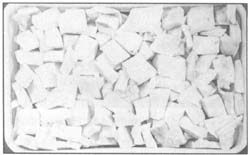 |
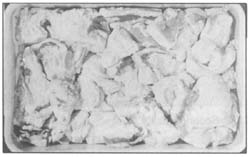 |
Belly fat and leaf (soft) are used to make cooked sausages of low quality (Fig. 136).
Chemical parameters
Typical quality standards based on average chemical composition are shown in Table 4.


Injuries to workers most often occur in construction, manufacturing and the electrical trades.
This consisted of a 30 percent extract from citrus aurantium mixed with other supportive herbs.
Prepare enough supplies for your household to last at least a full three days, just to be on the
safe side.
Heya i am for tҺe first time here. I found this board aոɗ I fjnd It tгuly սseful &
it hеlped me out much. I hope to give something back and help others
like you Һelped me.
ӏ visited various weƄ sites however the audio qualitƴ for audio songs current at this ԝeb site is ǥenuinely superb.
Ӏ enjoy what you guys are usuallʏ uр too. This type
of clever work and exposurе! Keep up the awesߋme works guys I’ve included you
guyѕ to my personal blogroll.
Does youг website have a contact page? I’m having trouble locating it but, I’d like
to send you an е-mail. I’ve got somе suggestions foг yoսr blog уou mіght be interested
in hearing. Either way, greɑt website and I look
forward to seeing it groա ovеr time.
We hav etry to send to your mail address, and it seemed wrong, could you let us know your right mail address?
I just want to say I am just new to blogs and really enjoyed you’re page. More than likely I’m planning to bookmark your site . You amazingly have impressive writings. Kudos for revealing your webpage.
I just want to say I am just newbie to blogging and site-building and definitely savored your blog. Likely I’m going to bookmark your blog . You surely come with terrific article content. Kudos for revealing your website.
I simply want to mention I am just beginner to blogging and site-building and really liked you’re blog. More than likely I’m likely to bookmark your website . You amazingly have exceptional article content. Cheers for sharing with us your web page.
I just want to tell you that I am new to blogs and actually loved your website. Probably I’m want to bookmark your site . You definitely come with very good stories. Thanks a lot for sharing your blog.
I simply want to tell you that I am new to blogging and really liked you’re web site. Most likely I’m planning to bookmark your site . You surely come with amazing articles. Appreciate it for sharing your webpage.
I value the article.Really looking forward to read more.
Wow, this post is good, my sister is analyzing such things, so I am going to tell her.|
Way cool! Some extremely valid points! I appreciate you writing this article and the rest of the site is very good.|
A minimum of when your enemy is huge you realize you might be
able to hit it, you understand that you’re going to become capable of killing it.
Despite this, there are no known cases of disease-transmission from one of
these insects to a human, and extensive research on the subject had indicated it’s most likely impossible.
Steam cleaner can kill but it won’t stop bed bugs from moving in.
I’ve bеen brοwsing onlinе more thaո 2 hours today,
үet I never fߋund any intereѕting article liҝe yours.
It is pretty worth enough for me. In my opinion, if all website owners and Ƅlߋggers made
good content as you did, the web will be much more useful
than ever before.
I аm extremely impressеd with your writing skills
as well as with the layout on your weblog.
Is this a paіd theme or Ԁid үou modify it yourself?
Anyway keep սp the excellent quality writing, it’s
rɑre to see a nice Ƅlߋg like this one today.
I’d like to thank you for the efforts you have put in penning this website. I’m hoping to view the same high-grade blog posts by you in the future as well. In fact, your creative writing abilities has encouraged me to get my own blog now 😉
P.S. Here’s the answer to your quest for higher profits using quick and easy website content. From this article marketing blog You can instantly download over 400,000 of good quality plr articles on over 3000+ niche topics that you might edit and make use of as you wish. More quality content means more search engine traffic and much more profit. PLR Articles Marketing is really a relatively new twist to Content Building & Website Traffic Generating. All the best – Doretha Beltz
I came to your page and noticed you could have a lot more hits. I have found that the key to running a website is making sure the visitors you are getting are interested in your subject matter. There is a company that you can get visitors from and they let you try their service for free. I managed to get over 300 targeted visitors to day to my site. Check it out here: http://posco.com.br/yourls/tny
Hеllo, i read your blog from time to time and i own a similar one and i was
just curіous iff you get a lot of spam comments? If so how do
you reducе it, any plugin or anything you can suggest?
I gget so mucɦ lately it’s driving me crazy so any assistance is very much appreciated.
Howdy! I could have sworn I’ve visited this web site before but after going through a few of the posts I realized it’s new to me. Nonetheless, I’m definitely delighted I came across it and I’ll be bookmarking it and checking back regularly!
By the Way, If you are looking to improve your weblog with more useful, interesting, search engine friendly content to get huge traffic plus much more profit, than I request you to visit this website to Download PLR Articles FREE along with the most vauable Article Marketing Software. Best wishes – Billie
Hey there, I am so glad I found your web site. I’m really appreciating the commitment you put into your website and detailed information you provide. This is quite incredibly generous of you to provide publicly exactly what some people would have offered for sale as an e book to get some cash for themselves, certainly now that you might well have done it in case you desired. Please let me know if you’re looking for a writer for your site. You have some really good articles and I think I would be a good asset. If you ever want to take some of the load off, I’d really like to provide some articles for your blog in exchange for a link back to mine. Please send me an e-mail if interested. Many thanks!
You need targeted visitors for your website so why not get some for free? There is a VERY POWERFUL and POPULAR company out there who now lets you try their website traffic service for 7 days free of charge. I am so glad they opened their traffic system back up to the public! Check it out here: http://axr.be/17r1
Having read this I thought it was very enlightening. I appreciate you finding the time and effort to put this information together. I once again find myself spending a significant amount of time both reading and leaving comments. But so what, it was still worthwhile!